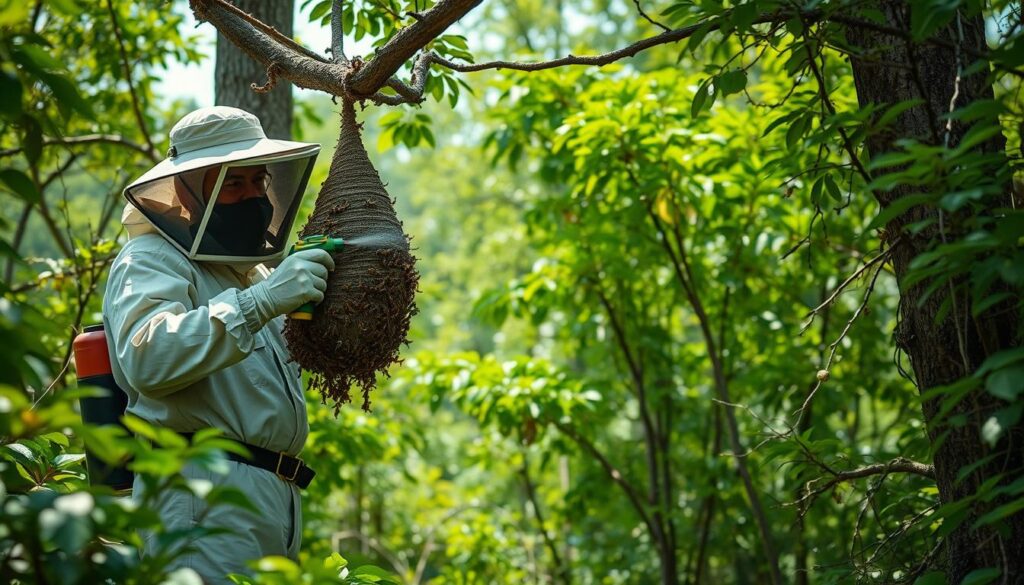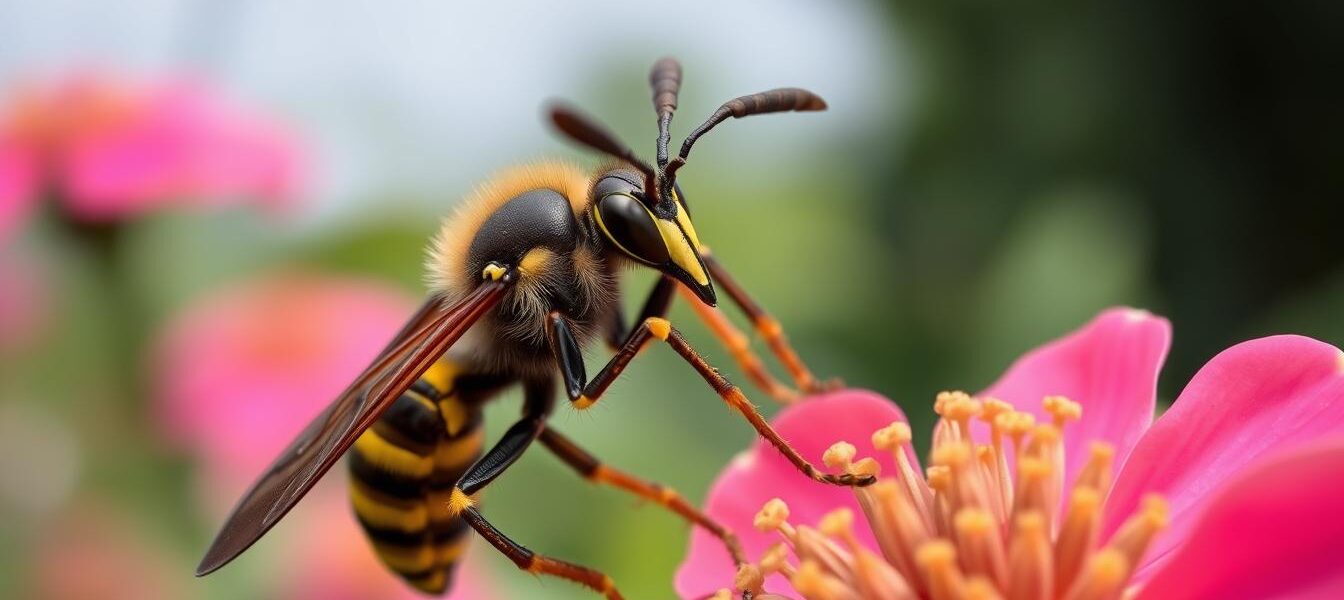Murder Hornets in US: What You Need to Know Now
Asian giant hornets, or “murder hornets,” have appeared in the United States. These invasive insects can grow up to two inches long. They pose a serious threat to honeybees.
The first sightings were near Blaine, Washington, in late 2019. Reports have since reached as far as Portland, Oregon. In 2021, a live Asian giant hornet was spotted in Whatcom County, Washington.
“Killer hornets” can destroy entire honeybee hives within hours. Their stings are painful to humans and can be deadly. In Japan, these hornets cause 30 to 50 deaths annually.
The invasion raises concerns about the declining U.S. honeybee population. It also poses potential health and economic risks to local communities.
Key Takeaways
- Asian giant hornets, also known as “murder hornets,” have been spotted in the Pacific Northwest region of the United States.
- These invasive insects pose a significant threat to honeybee populations, capable of decimating entire hives within hours.
- The Asian giant hornet sting can be extremely painful and potentially deadly to humans, causing an average of 30 to 50 deaths per year in their native Japan.
- The discovery of these hornets in the U.S. has raised concerns about the impact on the declining honeybee population and potential health and economic risks.
- Ongoing efforts are underway to manage, research, and educate the public about the Asian giant hornet invasion in the United States.
Understanding Murder Hornets: What Are They?
The Asian giant hornet is the world’s largest wasp. It comes from East Asia and Japan. These insects can grow up to 2 inches long with a 3-inch wingspan.
They have orange and black markings and large mandibles. Their stinger is a quarter-inch long. These features make them stand out among other insects.
Origin of the Species
The Asian giant hornet (Vespa mandarinia) forms colonies with one queen and many workers. They nest underground or in dead trees. Their life cycle starts in spring when queens build colonies.
The mating season for these hornets happens in fall. This is when new queens and males are produced.
Physical Characteristics
Queen hornets can grow up to 2 inches long. Workers are slightly smaller at 1.4 to 1.6 inches. Their sting packs a powerful punch.
One sting has a 50% chance of killing a decent-sized rodent. Unlike honeybees, these hornets can sting multiple times without dying.
Behavior and Habitat
Asian giant hornets can fly up to 6 miles from their hive. They are top predators in the insect world. These hornets are known for targeting honeybees.
Just 15 to 30 hornets can destroy a honeybee colony. They can wipe out 30,000 to 50,000 bees in hours.
“The Asian giant hornet, with a sting that few humans would forget, poses a threat to honeybees and can decimate entire hives.”
Why the Concern About Murder Hornets?
The Asian giant hornet, or “murder hornet,” has been spotted in the United States. These 2-inch insects threaten honeybees, which are vital for our ecosystem. Beekeepers and farmers are deeply worried about this new danger.
Threat to the Honeybee Population
Asian giant hornets are fierce predators of honeybees. European honeybees have no defense against these invaders. In just 90 minutes, one hornet can wipe out an entire honeybee colony.
Potential Human Health Risks
The hornet sting treatment is crucial because their venom can dissolve human flesh. As few as 50 stings can be fatal, causing kidney damage. In Japan, these hornets kill up to 50 people each year.
Economic Impact on Agriculture
These hornets could severely harm U.S. agriculture. Honeybees are essential for pollinating crops. Their decline could lead to lower crop yields and reduced agricultural output.
The U.S. Department of Agriculture reports that 35% of global food crops rely on pollinators. This highlights how important honeybees are for our food supply.
| Potential Impact | Statistic |
|---|---|
| Annual hive losses due to other factors | 29-45% since 2012 |
| Proportion of U.S. food crops dependent on pollinators | Approximately 1 out of every 3 bites of food |
| Annual deaths caused by Asian giant hornets in Japan | Up to 50 people |
The “murder hornet” poses a serious threat to honeybees, public health, and agriculture. We need to stay alert and work together to tackle this new challenge.

Identifying a Murder Hornet Nest
Asian giant hornets, or “murder hornets,” are a dangerous insect pest in the United States. Understanding their nesting habits is crucial for effective management. Knowing how to spot them helps distinguish them from other stinging insects.
Signs of a Nest’s Presence
Murder hornet nests are usually found underground or in dead tree cavities. Look out for large hornets measuring about 2 inches long. You might also find decapitated honeybees near active beehives.
- Sightings of the large, distinctive hornets, measuring around 2 inches in length.
- Discovering decapitated honeybees near active beehives, as these hornets are known to attack and kill colonies.
Difference Between Hornets and Bees
Murder hornets differ from bees in several ways. They have longer bodies and are much larger. Their heads are yellow-orange, with black and white stripes on their abdomen.
Recommended Safety Precautions
Dealing with murder hornet nests requires extreme caution. Regular beekeeping suits don’t protect against their long, venomous stingers. Contact local authorities or pest control experts to handle suspected murder hornet activity safely.
Many reported sightings, especially in eastern North America, are often misidentified. The European hornet looks similar but is less aggressive. Proper identification is key to responding appropriately and managing potential risks.
How to Report and Manage Encounters
Spot an Asian giant hornet? Report it to your local agricultural department right away. Washington State has set up traps and welcomes help from citizen scientists. These efforts aid in hornet nest eradication.
Reporting Sightings to Local Authorities
Quick reporting is key in managing these insect pest control issues. It helps track the spread of these invasive insects. This allows officials to take swift action against infestations.
Best Practices for Safe Removal
Never try to remove a nest by yourself. It’s extremely dangerous. Experts use special gear and methods for nest removal. They employ vacuum extraction and foam to seal nest entrances.
Infrared cameras and radio trackers help find and track hornets to their nests. Always seek professional help for nest removal.
Tools and Methods for Nest Management
Several tools aid in effective hornet nest eradication. Infrared cameras and radio trackers pinpoint nest locations. Experts use special gear and vacuum extraction for safe removal.
Teamwork is crucial in managing Asian giant hornet infestations. This includes experts, government agencies, and citizen scientists working together.

“While the hype around ‘murder hornets’ may be exaggerated, Asian giant hornets do pose a real threat to local pollinators and the economy of Washington State.”
Current Measures in Place in the U.S.
The U.S. government has taken strong action against Asian giant hornets, also called “murder hornets.” These efforts protect honeybees and reduce risks to people and farming. Washington State leads the charge in this fight.
Government Response and Research Efforts
Authorities have set up traps to watch for these giant hornets. Scientists study hornet behavior and ways to get rid of them. They use heat-sensing tools to find and destroy underground nests.
Researchers are working hard to understand these insects better. Their goal is to stop the hornets from spreading further.
Collaboration with Beekeepers
Washington State works closely with local beekeepers. Beekeepers help spot and report any sightings of Asian giant hornets. This teamwork allows for quick action when hornets are found.
Educational Outreach Initiatives
Public education programs help people identify Asian giant hornets. These efforts stress the importance of quick reporting. Early detection is key to stopping the spread of this invasive species threat.
“If we can’t get a handle on it in the next couple of years, it could become impossible to eradicate,” warned Sven-Erik Spichiger, the entomology program manager for the Washington State Department of Agriculture.
The U.S. government is taking this threat seriously. They work with communities and educate the public. These actions show how important it is to protect honeybees from Asian giant hornets.
What You Can Do to Help
We all play a part in fighting the invasive Asian giant hornet. These “murder hornets” have been spotted mainly in Washington State. Stay alert and take action to support local beekeepers and stop this dangerous species.
Supporting Local Beekeeping Efforts
Help by buying honey and bee-friendly products from local beekeepers. This keeps native bee populations strong for pollination and ecosystem health. Plant native flowers to give bees food and shelter.
Spreading Awareness in Your Community
Teach others about the Asian giant hornet. Share facts on how they look, act, and threaten our environment. Urge people to report sightings to local authorities quickly.
Taking Part in Citizen Science Projects
Many states run programs where volunteers set up hornet traps. Join these projects to help find and remove nests in your area. Your work can make a big difference in this fight.
FAQ
What are “murder hornets” and where do they come from?
“Murder hornets” are Asian giant hornets (Vespa mandarinia), native to East Asia and Japan. These invasive insects are the world’s largest wasps. Queens can grow up to 2 inches long with a 3-inch wingspan.
How big is the threat of Asian giant hornets in the United States?
Asian giant hornets pose a big threat to honeybees, especially European ones. They can wipe out a bee colony in just 90 minutes. Their venom can dissolve human flesh, and their stings can be deadly.
As few as 50 stings could cause death due to kidney damage. This makes them a serious concern for both beekeepers and humans.
How can you identify an Asian giant hornet nest?
Look for large hornets and decapitated bees near hives. These hornets have longer bodies, larger size, and orange-black coloring. Many reported sightings may be misidentifications of the less aggressive European hornet.
What should you do if you suspect you’ve seen an Asian giant hornet?
Report it right away to your local agricultural department. Washington State has set up traps and asks citizens to help monitor. Don’t try to remove nests yourself.
These hornets are very dangerous. Only professionals with proper gear should handle nest removal.
What is being done to combat the Asian giant hornet threat in the United States?
The U.S. government, especially in Washington State, is taking strong action. They’ve set up trap networks and are studying hornet behavior. They’re also developing ways to wipe out these pests.
Public education is ongoing. People are learning to spot Asian giant hornets and report sightings quickly.
How can the public help in the fight against Asian giant hornets?
You can support local beekeepers by buying their honey and bee-friendly plants. This helps keep native bee populations strong. Share accurate info about the hornets’ looks and behavior with your community.
Many states, including Washington, have projects where volunteers can help set up and check traps. Join these efforts to make a difference.
